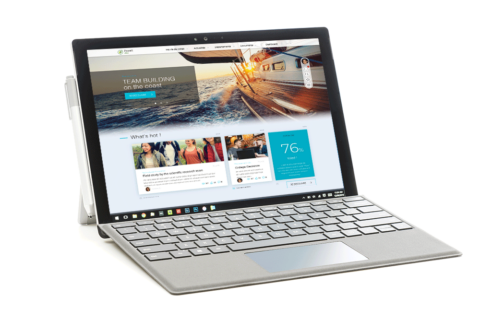As the future of work continues to evolve, one trend remains clear: remote working is here to stay. Organizations that once operated in traditional office spaces are now embracing the digital workplace, where flexibility, access, and seamless communication are paramount. In this new environment, leveraging an intranet for remote work isn’t just a nice-to-have—it’s essential. Social intranet software plays a pivotal role in ensuring business continuity, fostering company culture, and maintaining employee engagement, even when teams are physically apart.
By centralizing tools, communication, and collaboration into one accessible platform, companies can empower remote employees with everything they need to work efficiently and feel connected. This article explores eight impactful ways your company can enhance the employee experience by using an intranet tailored for remote work scenarios. Whether you’re a startup with a globally distributed team or a large enterprise scaling your hybrid model, the insights below will help transform your company intranet into a strategic asset.
Before diving into specific use cases, it’s important to understand that the true power of an intranet for remote work lies in its ability to unify people and processes under one digital roof. Whether your team is fully remote or operating in a hybrid model, the intranet serves as a central command center for collaboration, communication, and community, allowing for in-office and hybrid work productivity. With the right approach, it can be a catalyst for transforming disconnected teams into a highly engaged, purpose-driven remote workforce.
What is a social intranet, and why does it matter for remote work?
Most companies, even those that aren’t remote, use an intranet in some capacity. Intranets are somewhat broadly defined as internal networks that are used to store files and communicate. But intranets have been around for a long time, and many are outdated. As a result, the tools and functions available in each system vary.
A social intranet specifically refers to a more modern type of intranet that is equipped with tools like multiple communication methods, real-time document collaboration, and organization-wide forums for discussion. With a social intranet, employees don’t just access and share information. They connect, collaborate, and innovate.
8 ways an intranet supports remote teams
1. Stay in contact with streamlined communication
Undoubtedly, the biggest advantage to equipping a remote workforce with social intranet software is the way in which it facilitates communication. According to Buffer’s 2020 State of Remote Work, communication is the top challenge that remote employees face; a social intranet for remote work is the key to overcoming this barrier. Intranet communication tools are available anywhere, at any time, and from any device. Here are a few examples:
- Email: One of the longest-running forms of workplace communication, email still has its place on remote teams. Emails are useful for communicating internally about non-urgent matters and externally with partners and clients.
- Chat: Social intranet software like Microsoft Teams enables employees to quickly send instant messages, either between individuals or within groups.
- Video conferencing: Instead of gathering in the conference room, virtual employees convene for meetings over video calls. Videoconferencing software can even be used to host company-wide seminars and events.
- Forums: Forums are often an under-appreciated digital communication tool included in the social intranet. Employees can use these message boards to expand their networks, ask for help, and discuss topics of interest with anyone in the organization.
The ability to stay in contact in real time is foundational for remote teams. Beyond just standard communication, an effective intranet for remote work fosters transparency, consistency, and trust across departments. Social intranet platforms like Powell often integrate seamlessly with business-critical tools like Microsoft Teams and Outlook, streamlining internal messaging and ensuring that no employee is left out of the loop.
Notifications, newsfeeds, and team-specific channels allow remote workers to receive updates that are relevant to their roles. This helps reduce noise and increases the efficiency of communication flows. For example, a marketing team can have its own discussion board, while HR can maintain an employee support space—all within the same digital environment. Communication isn’t just about talking—it’s about building a digital bridge that every team member can walk across.
2. Collaborate efficiently on projects
When employees – remote or not – try to collaborate on work with a local file storage system, there’s a high potential for confusion with multiple versions of documents being emailed back and forth as each contributor makes their own changes. With an intranet, everyone works from a single copy of the same shared file, which is stored in the cloud and can be accessed from anywhere with an internet connection. Platforms such as Microsoft 365 even enable multiple users to work on the same document at the same time without losing any of their changes. This feature combined with robust communication options make collaboration just as easy as sitting in the same room together.
Collaboration remains one of the biggest challenges—and opportunities—when working remotely. With a social intranet, employees can collaborate asynchronously or in real time, eliminating the barriers of time zones and physical presence. Built-in intranet tools for project management, such as shared calendars, task trackers, and file repositories, help streamline the workflow for distributed teams.
When documents are stored on a centralized platform, everyone works from the same version, ensuring knowledge management is consistent and accurate. Additionally, remote workforce collaboration becomes more fluid when colleagues can instantly jump into a video meeting from a document page or leave threaded comments visible to all contributors.
3. Onboard new hires remotely with ease
An advantage of transitioning to a remote workforce is gaining access to the global talent pool. Onboarding these new remote employees is a much smoother process with a social intranet, from facilitating an engaging remote training process to providing recent hires with a platform to communicate. Remote employees feel more welcome from day one with the access a social intranet provides.
In a digital workplace, onboarding remote workers requires a well-thought-out, engaging experience that compensates for the lack of in-person connection. A mobile intranet makes it possible to guide new hires through an interactive journey that reflects your company culture. From accessing welcome videos and essential documents to meeting team members via video introductions, everything can be centralized in the intranet platform.
Using onboarding checklists, dashboards, and access to internal knowledge bases ensures new employees feel confident and empowered. Importantly, onboarding through an intranet for remote work isn’t just about task completion—it’s about creating a sense of belonging and connection.
4. Gather valuable employee feedback
Every company should be constantly gathering feedback to gauge the success of initiatives like digital adoption and employee engagement. Social intranet software offers a set of solutions that include polls and surveys for collecting input. Powell Intranet also empowers companies with social intranet analytics that give critical insight into how employees use tools and engage with content.
When managing a remote workforce, listening to employees becomes more critical than ever. Without casual hallway chats or drop-by feedback, leadership must proactively create digital spaces where feedback is welcomed. Social intranet tools offer surveys, polls, and suggestion boxes, empowering remote workers to share insights, concerns, or ideas.
Advanced intranet software even tracks employee engagement metrics, helping HR teams make informed decisions. By acting on this feedback, organizations show that even in a remote working model, every employee voice matters.

5. Facilitate networking and informal connections
Internal networking offers tremendous value for both remote employees and the companies they work for. On an individual basis, networking plays a central role in career development and future opportunities. But companies can also benefit from the innovation generated by circulating ideas across the organization. Social networks give employees the opportunity to expand their outer circle in a way that has never been possible.
While networking often happens organically in a physical office, remote workers need intentional digital spaces to build connections. An intranet for remote work allows companies to recreate these spontaneous moments through virtual lounges, interest groups, and employee spotlights. These features foster social interaction and help team members bond over shared hobbies or goals.
Internal networking can also support mentoring, leadership development, and knowledge sharing across departments. By proactively promoting cross-functional collaboration through the company intranet, businesses can unlock innovation and empower individuals to form relationships outside their immediate teams. These digital watercoolers play a crucial role in shaping a positive employee experience, especially for new hires and junior staff who may struggle to build visibility in a remote environment.
6. Encourage knowledge sharing and thought leadership
Not all intranet content comes from the top. On a social intranet platform, employees are free to become thought leaders and publish their own content in accordance with workplace guidelines. There’s even an opportunity to start an employee advocacy initiative by encouraging your remote workforce to share content with their own personal social networks.
Encouraging thought leadership within a company fosters a sense of ownership and employee engagement. Social intranet platforms are ideal for creating employee-generated content hubs where individuals can share insights, lessons learned, or success stories.
For remote teams, this type of content bridges the distance, creates visibility for talent, and encourages peer learning. Highlighting internal subject matter experts enhances not just your internal culture but your external reputation—especially when remote employees share blog posts, videos, or best practices across both the intranet and external social networks. Companies that foster thought leadership are more likely to build a knowledge-driven, purpose-centered workplace.
7. Promote a more inclusive remote culture
As companies pay more attention to workplace diversity, many are finding that social intranet tools help promote an inclusive culture. Certain groups that may have felt underrepresented in office spaces and in-person meetings face fewer barriers in a virtual environment. Of course, the ability to hire remotely also makes it easier for companies to bring in more diverse candidates over time.
Remote work environments can sometimes create challenges around equity and visibility. However, social intranet tools offer a unique opportunity to amplify underrepresented voices and provide equal access to communication channels. A well-structured intranet for remote work supports affinity groups, inclusive content strategies, and shared spaces for feedback.
Multilingual options, screen-reader compatibility, and visual customization features ensure that your digital workplace welcomes everyone. Hosting “Culture Moments” pages or giving voice to different employee communities fosters awareness and creates stronger connections across your remote teams.
8. Support employees through organizational change
In a digital environment, change is inevitable and constant. The most important part of a change management strategy is communication; Gartner finds that employees’ understanding of the reason for change plays a smaller role in overall success than the change itself. With a social intranet, companies can better communicate with their remote workforce and address the employee mindset component of new technological initiatives.
Managing organizational change is never easy—but it’s even more complex when dealing with a remote workforce. Clear, consistent, and empathetic communication is essential, and that’s where a social intranet becomes invaluable.
With intranet software, companies can create change communication hubs featuring explainer videos, roadmaps, and a space for Q&A. These hubs help build trust and allow remote employees to understand the “why” behind each change. Whether rolling out new tools, restructuring teams, or launching a new initiative, the intranet ensures alignment, visibility, and two-way communication across the remote team.
How Powell empowers remote collaboration
Helping distributed teams stay connected and productive
Remote collaboration must go beyond chat tools and file sharing. Powell Software provides a comprehensive intranet for remote work that brings your people, processes, and tools together in a single, intuitive platform.
Powell’s solution is built to help distributed teams thrive—whether they’re across departments, countries, or time zones. With deep integration into Microsoft 365, Powell ensures that your teams can access everything they need in one place: from Teams conversations to SharePoint libraries, task lists, calendars, and company-wide updates. Employees can collaborate in real-time, launch a video meeting directly from a document page, or contribute to a shared knowledge base without switching platforms.
What truly sets Powell apart is its ability to support meaningful connections. Through customizable employee directories, engagement-driven features like kudos walls and polls, and vibrant news hubs, the Powell intranet strengthens your company culture while keeping productivity at the forefront.
Why Powell is the right intranet solution for remote work
If you’re looking for a social intranet that does more than store files or broadcast announcements, Powell Software delivers a solution designed for the future of work. With a user-friendly design, mobile accessibility, and powerful governance features, Powell strikes a balance between ease of use for employees and security and compliance for IT teams.
Here’s why businesses around the world choose Powell for their intranet for remote work:
✅ Centralized experience: Everything your remote employees need—news, apps, documents, updates—is accessible from a single entry point.
✅ Employee engagement: Features like recognition widgets, feedback forms, and communities keep people connected and involved.
✅ Scalable and secure: Built on Microsoft 365, Powell supports organizations of all sizes while ensuring intranet security for remote work, access control, and seamless administration.
✅ Tailored to your brand: Custom branding ensures that your digital workplace reflects your identity and reinforces your company culture, wherever your team members are.
Whether you’re transitioning to remote working tools, scaling a hybrid model, or simply looking to improve how your teams connect, Powell is the intranet boost you need. It’s not just software—it’s a smarter way to collaborate in the age of digital flexibility.
Have you given thought to how you’ll manage change while adopting a social intranet in your organization? Powell Intranet was created to help companies with a smooth and fast transition, so your remote workforce can get back to doing what they do best. Contact us to set up a demo and see how easy it is to deploy our social intranet software.





